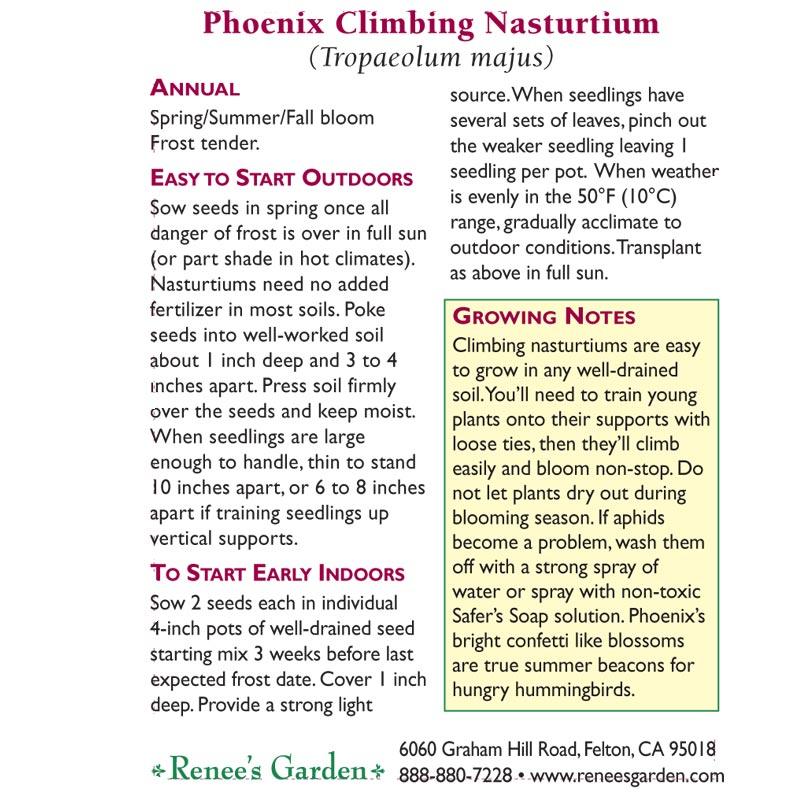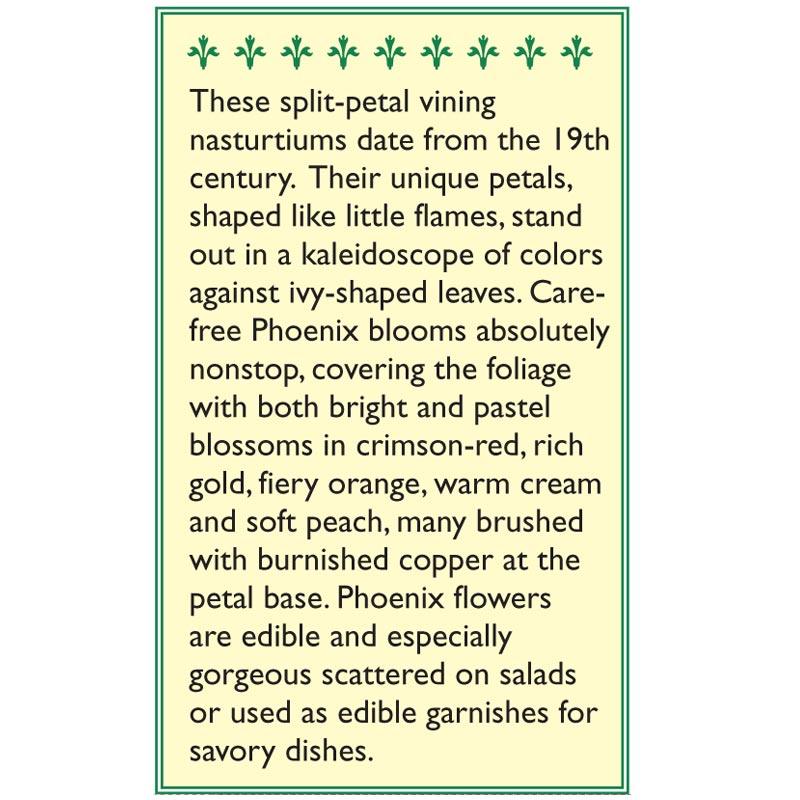Item Number: SWF5983
Phoenix Climbing Nasturtium Flower Seeds
Blooms Nonstop with Edible Flowers
Nasturtium - Climbing Phoenix (Heirloom) - Tropaeolum majus
Annual – These split-petal vining nasturtiums date from the 19th century. Their unique petals, shaped like little flames, stand out in a kaleidoscope of colors against ivy-shaped leaves. Carefree Phoenix blooms absolutely non-stop, covering the foliage with both bright and pastel blossoms in crimson-red, rich gold, fiery orange, warm cream, and soft peach, many brushed with burnished copper at the petal base. Phoenix flowers are edible and especially gorgeous scattered on salads or used as edible garnishes for savory dishes.
Soil & Water: Climbing nasturtiums are easy to grow in any well-drained soil. Fertilizer is usually not necessary, and too much nitrogen will create bountiful foliage without much flowering. You'll need to train young plants onto their supports with loose ties, then they'll climb easily and bloom non-stop. Do not let plants dry out during the blooming season.
Planting & Growing:
To Start Outdoors: Sow seeds in spring, once all danger of frost is over, in full sun (or part shade in hot climates). Poke seeds into well-worked soil about 1" deep and 3 - 4" apart. Press soil firmly over the seeds and keep moist. When seedlings are large enough to handle, thin to stand 10" apart, or 6 - 8" apart if training seedlings up vertical supports.
To Start Early Indoors: Sow 2 seeds in individual 4" pots of well-drained seed starting mix 3 weeks before the last expected frost date. Cover 1" deep. Provide a strong light source. When seedlings have several sets of leaves, pinch out the weaker seedling, leaving 1 seedling per pot. When weather is evenly in the 50's, gradually acclimate to outdoor conditions. Transplant as above in full sun.
Soil Temperature: above 50°F
Planting Depth: 1"
Germination: 10-12 Days
Height At Maturity: 4-6 feet
Sun/Shade: Full to Partial Sun
Spacing After Thinning: 6-8"
Approx Seeds per Pack: 40-45 Seeds
Climbing Nasturtiums, scientifically known as Tropaeolum majus, are a captivating addition to any garden. These versatile plants are renowned for their vibrant flowers and edible leaves, making them a favorite among garden enthusiasts. The Phoenix Climbing Nasturtium Flower Seeds offer a unique opportunity to grow these stunning plants, which are known for their vibrant and colorful blooms. Discover the characteristics of Phoenix Climbing Nasturtiums and how to cultivate and enjoy them in your garden.
The Beauty of Climbing Nasturtiums
Climbing Nasturtiums are celebrated for their remarkable beauty. Their distinctively shaped leaves and brilliant, trumpet-shaped flowers add a touch of elegance to gardens, balconies, and trellises. Available in various shades of red, orange, and yellow, they bring a burst of color to outdoor spaces. Here's what you need to know about these seeds:
Cultivating Climbing Nasturtiums
Growing Climbing Nasturtiums from seeds is a rewarding experience that can enhance your garden's aesthetic appeal and provide you with edible leaves and flowers. Below are some key steps to successfully cultivate these captivating plants:
- Seed Sowing: Start by sowing the Climbing Nasturtium seeds directly into well-drained soil after the last frost has passed. These seeds are relatively easy to work with, and you can plant them about 1 inch deep and 2 inches apart.
- Sunlight Requirements: Climbing Nasturtiums thrive in full sunlight but can tolerate partial shade. Ensure they receive at least 6 hours of sunlight daily for optimal growth and flowering.
- Watering: These plants prefer consistently moist soil. However, be cautious not to overwater, as this can lead to root rot. A moderate watering routine should suffice.
- Support and Trellising: As Climbing Nasturtiums grow, they require support for their trailing vines. Provide them with trellises, fences, or other structures to climb upon. This not only encourages upward growth but also showcases their stunning foliage and flowers.
- Edible Delights: One of the unique aspects of Climbing Nasturtiums is that both their leaves and flowers are edible. The leaves have a peppery, slightly spicy flavor, making them a delightful addition to salads or as a garnish. The flowers, with their vibrant colors, can be used to elevate the visual appeal of dishes.
Attracting Beneficial Insects
Climbing Nasturtiums play a significant role in attracting beneficial insects to your garden. Their bright blooms are particularly attractive to pollinators like bees and butterflies. These insects contribute to the overall health of your garden by aiding in the pollination of other plants. Having Climbing Nasturtiums nearby can create a more balanced and biodiverse garden ecosystem.
Natural Pest Control
Besides their allure to pollinators, Climbing Nasturtiums also serve as a natural form of pest control. They release chemicals that repel certain pests, such as aphids and whiteflies, helping to protect neighboring plants from infestations. By strategically planting Climbing Nasturtiums, you can create a barrier against these garden nuisances.
Climbing Nasturtium seeds offer garden enthusiasts a delightful way to enhance their outdoor spaces with vibrant colors and unique foliage. These easy-to-grow plants not only add aesthetic charm but also contribute to a healthier garden ecosystem by attracting pollinators and serving as natural pest repellents. Furthermore, their edible leaves and flowers provide an exciting culinary dimension, making Climbing Nasturtiums a versatile and appealing addition to any garden.
Check Your Zone Compatibility:
Compatible with your zone.
Growing Zone for

Our Guarantee To You
Since 1976, we've served our customers at every stage of growing. Please contact us at any time. We are happy to support and assist you.
Shipping Information
Shipping Information
Shipping Weight: 0.01 lb
Dimensions: 4.5"L x 3.125"W x 0.1"H
Features
Features
- Attracts Beneficial Insects
- Attracts Hummingbirds
- Easily Established
- Edible Flower
- Good for Beginners
- Grow on a Trellis
- Heirloom
- Requires Staking
- Requires Summer Water
- Useful for Ornamental
Characteristics
Characteristics
Planting & Care
Planting & Care
Soil & Water: Climbing nasturtiums are easy to grow in any well-drained soil. Fertilizer is usually not necessary and too much nitrogen will create bountiful foliage without much flowering. You'll need to train young plants onto their supports with loose ties, then they'll climb easily and bloom non-stop. Do not let plants dry out during blooming season.
Planting & Growing:To Start Outdoors: Sow seeds in spring, once all danger of frost is over, in full sun (or part shade in hot climates). Poke seeds into well-worked soil about 1" deep and 3 - 4" apart. Press soil firmly over the seeds and keep moist. When seedlings are large enough to handle, thin to stand 10" apart, or 6 - 8" apart if training seedlings up vertical supports. To Start Early Indoors: Sow 2 seeds in individual 4" pots of well-drained seed starting mix 3 weeks before last expected frost date. Cover 1" deep. Provide a strong light source. When seedlings have several sets of leaves, pinch out the weaker seedling leaving 1 seedling per pot. When weather is evenly in the 50's, gradually acclimate to outdoor conditions. Transplant as above in full sun.
Useful Information
Useful Information
Guarantee
Guarantee
Share








